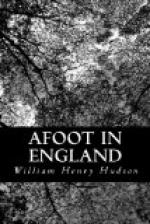No sooner was it dark than all were in bed and asleep; not one square path of yellow light was visible. To enjoy the sensation I went out and sat down, and listened alone to the liquid rippling, warbling sound of the swift-flowing streamlet—that sweet low music of running water to which the reed-warbler had listened thousands of years ago, striving to imitate it, until his running rippling song was perfect.
A fresh surprise and pleasure awaited me when I explored the coast east of the village; it was bold and precipitous in places, and from the summit of the cliff a very fine view of the coast-line on either hand could be obtained. Best of all, the face of the cliff itself was the breeding-place of some hundreds of herring-gulls. The eggs at the period of my visit were not yet hatched, but highly incubated, and at that stage both parents are almost constantly at home, as if in a state of anxious suspense. I had seen a good many colonies of this gull before at various breeding stations on the coast—south, west, and east—but never in conditions so singularly favourable as at this spot. From the vale where the Branscombe pours its clear waters through rough masses of shingle into the sea the ground to the east rises steeply to a height of nearly five hundred feet; the cliff is thus not nearly so high as many another, but it has features of peculiar interest. Here, in some former time, there has been a landslip, a large portion of the cliff at its highest part falling below and forming a sloping mass a chalky soil mingled with huge fragments of rock, which lies like a buttress against the vertical precipice and seems to lend it support. The fall must have occurred a very long time back, as the vegetation that overspreads the rude slope—hawthorn, furze, and ivy—has an ancient look. Here are huge masses of rock standing isolated, that resemble in their forms ruined




